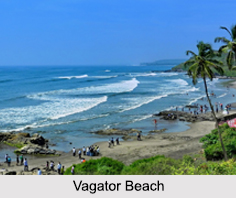 The Vagator Beach is located on the opposite bank of the Chapora River from the census town of Morjim in Pernem. It is the northernmost beach of the Bardez Taluka in Goa and is about 24 km away from Panaji, the capital city of Goa.
The Vagator Beach is located on the opposite bank of the Chapora River from the census town of Morjim in Pernem. It is the northernmost beach of the Bardez Taluka in Goa and is about 24 km away from Panaji, the capital city of Goa.
Description of Vagator Beach
The Vagator Beach is a clean and quiet tourist place, which is split into two as it is separated by a headland. As one faces the sea, on the right side is the North or Big Vagator Beach and on the left is the Ozran Beach, more commonly known as the Little Vagator Beach. The Vagator Beach is known to have dramatic red cliffs looking down on the shore and two fresh water springs.
The Vagator beach is separated by barely a couple of km of cliff tops and parched grassland from its nearest neighbour, the Anjuna Beach. A desultory collection of dilapidated farmhouses and picturesque Old Portuguese bungalows are scattered around a network of leafy lanes. The Chapora Fort offers a splendid view of the adjoining coast and the hills at a distance. This 500 years old fort was built by the Portuguese to secure their fortress from the Marathas.
The ideal time to visit the Vagator Beach is between the months of November and February when the climate is cool and pleasant. The Vagator Beach is famous for its dance parties and psychedelic music from different DJ"s around the world. The 2013, Sunburn Festival was hosted here after it was shifted from Candolim Beach. During the Christmas and New Year"s Eve, the Hill Top in Vagator is popular for rave parties with various DJ"s coming together from around the world to perform.
The Vagator Beach also has a number of Mediterranean and Indian restaurants and cafe serving a variety of food and drink. Some of these are only open in the tourist season.
Visiting Information on Vagator Beach
The Anjuna, Chapora and Mapusa are the nearest towns to Vagator Beach while the Thivim railway station is the closest at a distance of about 18 km. The Dabolim Airport is the nearest at a distance of about 44 km from the beach and is well connected via roadways.



















